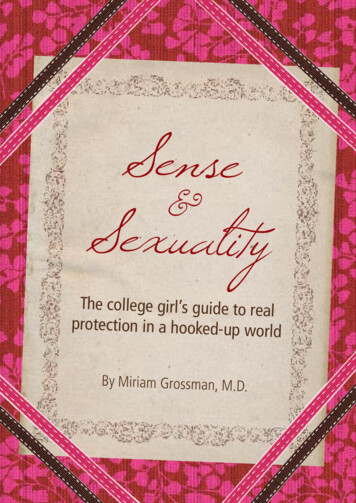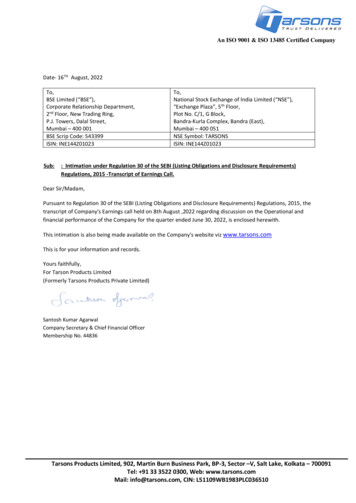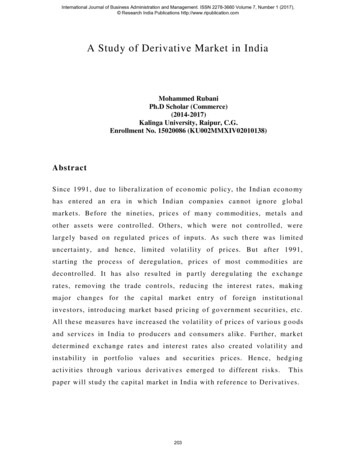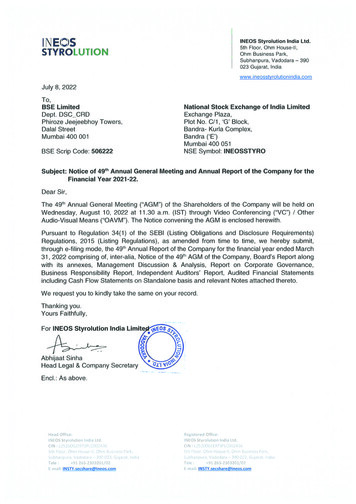
Transcription
Sense&SexualityThe college girl’s guide to realprotection in a hooked-up worldBy Miriam Grossman, M.D.
Sense&SexualityBy Miriam Grossman, M.D. Copyright 2008Clare Boothe Luce Policy Institute
Welcome to campus, girls.Don’t take this the wrong way, but I hope tonever see you in my office.For more than ten years I’ve been a physicianat a campus counseling center, and hardly a dayhas gone by without my meeting a young womanlike you. She’s working hard to fulfill her dreams:a college education, maybe grad school, a greatcareer, and—at some point—a home, husband,and kids. But she’s in crisis, and there are lots oftears as she shares her struggles and setbacks. I feelterrible, but there’s not much I can do.You see, by the time she comes into my office,it’s after the fact. She’s already made decisionsshe regrets. She’s already involved with the wrongguy, or infected with genital warts or herpes.She’s already lost a great relationship, missed anopportunity, or failed a midterm. I’m her doctor, butall I can do is sit there, listen, and hand her tissues.The worst part? Many times the crisis was 100percent preventable. If only I’d known she says.If only someone had told me.I’ve written this for you—for young womeneverywhere—so you won’t ever utter those words.No, this is not a guide to “safer sex.” Those areeasily available elsewhere. What you’ll find here isClare Boothe Luce Policy Institute
critical health information you’ve probably neverheard, facts that can help you avoid some of thedisappointments and troubles so many collegewomen experience.Look, there are irritations you may face incollege that are out of your control: roommateswho endlessly hit “snooze”; weird dorm odors;mandatory Friday morning lab; a computercrash at the worst possible time. They may seemdisastrous, but someday, when you recall them,you’ll laugh.Then there are challenges you may face incollege, or later, that will never bring a smile.Blisters or warts in private places. Meaningless,regrettable sex. Pre-cancerous conditions. Agerelated infertility. These are huge issues that affectwomen more often than men. They can throw yourlife plans off track. They can stand between you andyour dreams.The good news? It’s in your hands. You canavoid joining the patients who stream into myoffice saying, if only I’d known.I want you to dream big, girls, because there’sso much to look forward to. Just know this: you’vegot to play it smart.
1Intimacypromotesattachment& trust.Clare Boothe Luce Policy Institute
Intimate behavior floods your brainwith a chemical that fuels attachment.Cuddling, kissing, and sexual contact releasesoxytocin, a hormone that announces: I’m withsomeone special now. Time to switch love on, andcaution off.When oxytocin levels are high, you’re morelikely to overlook your partner’s faults, and totake risks you otherwise wouldn’t. So you certainlydo not want your brain drenched in this hormonewhen making critical decisions like, What do Ithink of him? How far do I want this to go?When it comes to sex, oxytocin, like alcohol,turns red lights green. It plays a major role inwhat’s called “the biochemistry of attachment.”Because of it, you could develop feelings for aguy whose last intention is to bond with you. Youmight think of him all day, but he can’t rememberyour name.
2Science confirms:alcohol makeshim hot . whenhe’s not.Clare Boothe Luce Policy Institute
Did you hear? Science has confirmed theexistence of “beer goggles”—when aperson seems more attractive to you after you’vehad a few drinks. Enjoy a glass of wine or a coupleof beers at a party, and the guy hitting on youbegins to look better than when you arrived. Itworks the other way too: guys will find your faceprettier after they’ve had a few.In a British study, 80 college students ratedphotos of unfamiliar faces of men and women theirage; alcohol consumption significantly raised thescores given to photos of the opposite sex. Drinking affects the nucleus accumbens, the area of thebrain used to determine facial attractiveness. It’sprobably one of several reasons that casual, highrisk sex is often preceded by alcohol consumption.In the morning, you both look different.
3A hook-up usuallyleads to regret.Clare Boothe Luce Policy Institute
Arecent study of the hook-up culture atPrinceton University reveals :Before the hook-up: Girls expect emotionalinvolvement almost twice as often as guys; 34%hope “a relationship might evolve.” Guys, morethan girls, are in part motivated by hopes ofimproving their social reputation, or of braggingabout their exploits to friends the next day.After the hook-up: 91% of girls admit to havingfeelings of regret, at least occasionally. Guilt and“feeling used” are commonly cited, and overall,80% of girls wish the hook-up hadn’t happened.Why don’t you hear about this? Studentsmay conceal these negative reactions, the studyindicated, because they perceive them as differentfrom their peers’.Other studies have shown: 84% of womensaid that after having sex a few times, even withsomeone they didn’t want to be emotionallyinvolved with, they begin to feel vulnerable andwould at least like to know if the other person caresabout them.As the number of casual sex partners in thepast year increased, so did signs of depression incollege women.49% of students whose hook-up includedintercourse never see one another again, and less than10% of “friends with benefits” develop into romances.
4A younger cervixis more vulnerableto infection.Clare Boothe Luce Policy Institute
Your cervix, the entrance to your uterus, hasa vulnerable area one cell thick, called thetransformation zone. It’s easy for HPV (the humanpapillomavirus, which can cause genital warts, andeven cervical cancer) to settle in there. That’s whymost teen girls are infected from one of their firstsexual partners. By adulthood the transformationzone is replaced with a thicker, tougher surface. Soit’s wise to delay sexual activity, or, if you’ve alreadystarted, to stop.Even though these infections are common, andusually disappear with time, learning you have onecan be devastating. Natural reactions are shock,anger, and confusion. Who did I get this from, andwhen? Was he unfaithful? Who should I tell? Andhardest of all: Who will want me now?These concerns can affect your mood,concentration, and sleep. They can deal a seriousblow to your self esteem. And to your GPA.The HPV vaccine is a major achievement,but the protection it provides is limited. You arestill vulnerable to other infections like herpes,chlamydia, HIV, and non-covered strains of HPV.And of course no vaccine prevents a broken heart.
5He may notknow he hasHPV or herpes.Clare Boothe Luce Policy Institute
Most guys who have a sexually transmittedinfection don’t know it. Routine testingfor men does not provide information about HPVor herpes. So if you end up—like so many sexuallyactive women on campus—getting bad news at thehealth center, don’t assume you’ve been lied to.When he told you he’s “clean,” that’s probably whathe believed.It’s easiest to transmit herpes or HPV when wartsor sores are present, but it can also happen at othertimes, when everything looks OK. Condoms reducethe risk by 60–70%. So you may still pay a price,even if you both are tested and you use a condomevery time.One reason genital infections are so commonin young women is because so many young menunknowingly carry them. The best course is todelay sexual activity, and eventually commit tosomeone who also waited. The closer you get tothat ideal, the better your chances of enjoying a lifefree of these worries.
6The rectum isan exit, not anentrance.Clare Boothe Luce Policy Institute
And about those other sexual activities .Having more than five oral sexpartners has been associated with throat cancer.Turns out that HPV can cause malignant tumors inthe throat, just like it does in the cervix.In a study of sexually active college men, HPVwas found both where you’d expect—the genitalarea—and where you wouldn’t: under fingernails.Yes, you read that right. Researchers now speculatewhether the virus can be shared during activitiesconsidered “safe,” like mutual masturbation.According to the Centers for Disease Control,approximately 30% of all women will have hadanal intercourse by the age of 24. Even withcondoms, this behavior places them at increasedrisk of infection with HIV and other STDs. Forexample, the risk for HIV transmission during analintercourse is at least 20 times higher than withvaginal intercourse.The government website, www.fda.gov, providesno-nonsense advice about avoiding HIV: “Condomsprovide some protection, but anal intercourse issimply too dangerous to practice.”The rectum is an exit, not an entrance. Analpenetration is hazardous. Don’t do it.
7Your fertility isa window ofopportunity thatwill close.Clare Boothe Luce Policy Institute
Seventy-five percent of college freshmensay that raising a family is an “essential orvery important goal.” But 55% of younger highachieving women are childless at 35. And 89% ofthem think they’ll be able to get pregnant intotheir forties.OK, time out. It’s easiest for a woman toconceive and deliver a healthy child in hertwenties. Fertility declines slightly at 30, andmore dramatically at 35. You may imagine thatthe waiting rooms of fertility clinics are packedwith obese women smoking cigarettes. If so,you’re wrong: they are filled with health-consciouswomen who work out and count calories. They arethere because they’re forty.If having children is one of your dreams, itwon’t hurt to keep these facts in mind as youmake decisions about careers and relationships.Remember that motherhood doesn’t always happenwhen the time is right for you; there’s a window ofopportunity, then the window closes.For some women, just as this window isclosing, they feel an unexpected longing for a child.It saddens me each time a patient describes this—typically a student who always put career first, andis finally getting a Ph.D. at 38 or 40. She’s thrilledto reach that milestone, but aches for another: tofeel a new life inside her, to give birth.
The rewards of sexuality—with the right guy,at the right time—are immense. Ask an olderwoman you respect who waited and chosethe right man; you might be surprised to hearher describe love and passion that has lasted fordecades—and keeps getting better.Yet you’re bombarded with a different message:you can reap these rewards with nearly anyguy, at almost any time. You’ve been told thatexploring and experimenting—as long as you’re“protected”—can be safe, satisfying, and beneficial.Don’t fall for it. It’s easy to forget, but thecharacters on Grey’s Anatomy and Sex in the Cityare not real. In real life, Meredith and Carrie wouldhave warts or herpes. They’d likely be on Prozacor Zoloft. Today a woman cannot have so manypartners without paying a price.“Safer sex” guidelines were developed beforeyou were born, but now we live in a different world.Now we’re fighting a horde of bugs, and the bugsare winning. It’s no longer enough to communicatewith your “partners”, get tested, and use condoms.In this century, if you wish to avoid genitalinfections, you need a different plan.Recognize that sexual activity—any genitalClare Boothe Luce Policy Institute
contact with another person—is a serious matter. Asingle encounter can have life-long consequences,especially for a woman. That’s not sexist, that’sbiology—your biology. Ignorance or denial of thisfact will only increase your vulnerability—don’tlet that happen. Instead, learn about the distinctsensitivities of being female—go beyond thebrief information provided here—and use thatknowledge to inform your decisions. That’s realempowerment.You’re in control, it’s all in your hands. Thedistress that often follows casual sex is 100%preventable. Life may throw you some curve balls,but STDs, and encounters you’d rather forget, areburdens that you can avoid.Listen to the lesson of hard science: it’s wiseto be very, very careful about who you allow to getclose to you.I believe in you. And I don’t want to see you inmy office. Now go pursue your dreams.Miriam Grossman, M.D.
For Your BookshelfThe Female Brain by Louann Brizendine, M.D.Taking Sex Differences Seriously by Steven E. Rhoads, Ph.D.Unprotected by Miriam Grossman, M.D.Works CitedSH Ebrahim et al (2005) Sexual Behavior: related adverse health burden in the United StatesSexually Transmitted Infections; 81, pp 38-40Louann Brizendine (2006) The Female Brain, Broadway BooksM Kosfeld et al, (2005) Oxytocin Increases Trust in Humans, Nature 435Barry T Jones et al (2003) Alcohol consumption increases attractiveness ratings of oppositesex faces, Addiction, 98, pp1069-1075Baumann, M.E. (2007) The “Hookup Culture”: Pluralistic Ignorance and Its Consequences.Unpublished undergraduate thesis, Princeton University, New Jersey.Anne Campbell (2008) The Morning after the Night Before Human Nature 19:157-173Townsend, JM (1995) Sex Without Emotional Involvement: An Evolutionary Interpretation ofSex Differences, Archives of Sexual Behavior, 24;2: p 187C Grello et al(2006) No Strings Attached: The Nature of Casual Sex in College Students, TheJournal of Sex Research, 43, 3:pp 255-267Elizabeth L Paul et al(2000) “Hookups”: Characteristics and Correlates of College Students’Spontaneous and Anonymous Sexual Experiences The Journal of Sex Research 37.1Melissa A Bisson and Timothy R Levine (2007) Negotiating a Friends with Benefits Relationship Archives of Sexual Behavior, 10.007Reitano, M(1997) Counseling Patients with Genital Warts, American Journal of Medicine,102(5A):38-43Rachel Winer, et al (2006) “Condom Use and the Risk of Genital Human PapillomavirusInfection in Young Women,” New England Journal of Medicine, 354;25D’Souza et al (2007) Case-Control Study of Human Papillomavirus and OropharyngealCancer, New England Journal of Medicine, 356;19Jeffrey M Partridge et al(2007) Genital Human Papillomavirus Infection in Men: Incidenceand Risk Factors in a Cohort of University Students, Journal of Infectious Diseases, 196(15 October) pp 1128-36, http://www.cdc.gov/nchs/data/ad/ad362.pdfBeena Varghese et al (2002) Reducing the Risk of Sexual HIV Transmission: Quantifying thePer-Act Risk for HIV on the Basis of Choice of Partner, Sex Act, and Condom Use, SexuallyTransmitted Diseases Vol 29, No 1, pp38-44Rachel Winer, et al (2006) “Condom Use and the Risk of Genital Human PapillomavirusInfection in Young Women,” New England Journal of Medicine, 354;25D’Souza et al (2007) Case-Control Study of Human Papillomavirus and OropharyngealCancer, New England Journal of Medicine, 356;19The Chronicle of Higher Education, January 26, 2007www.worklifepolicy.org, 4/15/2002“Ice, Ice Baby,” Elle, April 2004 (from www.extendfertility.com)
Author Miriam Grossman, M.D. servedas a Senior Fellow with the ClareBoothe Luce Policy Institute. For moreinformation, visit www.cblpi.org orcall us toll-free at (888) 891-4288.This booklet is available for reprinting atwww.cblpi.org/senseandsexuality/Copyright 2008 by the Clare Boothe Luce Policy Institute
from theeClare Boothe LucPolicy Institute
Clare Boothe Luce Policy Institute. S eventy-five percent of college freshmen say that raising a family is an "essential or very important goal." But 55% of younger high-achieving women are childless at 35. And 89% of them think they'll be able to get pregnant into











